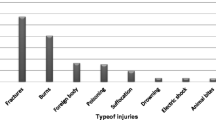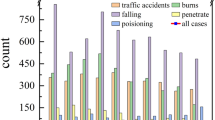Abstract
Objective
To study the profile and various risk factors associated with unintentional injuries in children.
Methods
The study is a cross sectional analysis of data collected from 351 children presenting with unintentional injury to a tertiary care hospital in Navi Mumbai, India. Data were collected about variables based on Haddon Phase Factor Matrix — host, environment and agent factors. Proportions for categorical variables across various groups were compared using Chi square test or Fisher’s exact test. Logistic regression model was used to evaluate the factors.
Results
Falls (36 %) were the most common injuries followed by bites (23 %). Majority of children were school going children (38 %) followed by preschool children (29 %). Forty-seven percent were from lower socioeconomic class. Commonest place of injury was home (48 %) and the commonest time was evening (49 %). Though there was male predominance in injuries, the difference across gender did not vary significantly (p = 0.15). Poisonings were significantly more common in infants and toddlers and in rural population (p < 0.001); kerosene being the commonest agent. Rural population is at more risk of bites compared to urban (p < 0.001); dog bites being the commonest followed by scorpion bites. Foreign bodies were significantly more common in upper and middle socioeconomic class and bites, in lower socioeconomic class (p < 0.005). Injuries from rural area and lower socioeconomic class were more serious, requiring hospitalization; they were also more likely to present late to the hospital (p < 0.05).
Conclusions
Profile of injuries varies widely as per the variations in agent, host and environmental factors. Socio-environmental, economic conditions and infancy-toddler age groups are predisposing risk factors for bites and poisoning. Although rural areas and lower socioeconomic class population are more vulnerable to serious types of injuries, they still lack essential basic medical care.
Similar content being viewed by others

Explore related subjects
Discover the latest articles and news from researchers in related subjects, suggested using machine learning.References
World report on child injury prevention. Geneva: World Health Organization and UNICEF; 2008. p.3–4.
Baker SP. Where have you been and where are you going with injury control? In: Mohan D, Tiwari G, editors. Injury prevention and control. New York: Taylor and Francis Publishers; 2000.
Robertson LS. Injuries: causes, control strategies and public policy. Cambridge, MA: LesingtonBroks; 1983.
Haddon W Jr. The changing approach to the epidemiology, prevention, and amelioration of trauma: the transition to approaches etiologically rather than descriptively based. Am J Public Health Nat Health. 1968;58:1431–8.
Patro BK, Jeyashree K, Gupta PK. Kuppuswamy’s socioeconomic status scale 2010—the need for periodic revision. Indian J Pediatr. 2012;79:395–6.
Adesunkanmi AR, Oginni LM, Oyelami AO, Badru OS. Epidemiology of childhood injury. J Trauma. 1998;44:506–12.
Bangdiwala SI, Anzola-Perez E. The incidence of injuries in young people: II log-linear multivariable models for risk factors in a collaborative study in Brazil, Chile Cuba and Venezuela. Int J Epidemiol. 1990;19:125–32.
Charles CC, Chenq JCY, Wong TW, et al. An international comparison of childhood injuries in Hong Kong. Inj Prev. 2000;6:20–3.
Jolly DL, Moller JN, Volkmer RE. The socio-economic context of child injury in Australia. J Paediatr Child Health. 1993;29:438–44.
Lyons RA, Jones SJ, Deacon T, Heaven M. Socioeconomic variation in injury in children and older people: a population based study. Inj Prev. 2003;9:33–7.
Roberts I, Power C. Does the decline in child injury mortality vary by social class? A comparison of class specific mortality in 1981 and 1991. BMJ. 1996;313:784–6.
Kumar V. Accidental poisoning in south west Maharashtra. Indian Pediatr. 1991;28:731–5.
Mehta A, Kasla RR, Bavdekar SB, Hathi GS, Joshi SY. Acute poisonings in children. J Indian Med Assoc. 1996;94:219–21.
Shetty RA, Chaturvedi S, Singh Z. Profile of animal bite cases in Pune. J Commun Disord. 2005;37:66–72.
Dutta JK. Control of rabies in south east Asia region countries- current problems. APCRI J. 2007;9:28–9.
Ong ME, Ooi SB, Manning PG. A review of 2, 517 childhood injuries seen in a Singapore emergency department in 1999–mechanisms and injury prevention suggestions. Singap Med J. 2003;44:12–9.
Nath A, VA N. Minor injuries among under-fives in a south Indian village. Indian Pediatr. 2009;46:621–3.
Morrongiello BA. Caregiver supervision and child-injury risk: I. Issues in defining and measuring supervision; II. Findings and directions for future research. J Pediatr Psychol. 2005;30:536–52.
Landen MG, Bauer U, Kohn M. Inadequate supervision as a cause of injury deaths among young children in Alaska and Louisiana. Pediatrics. 2003;111:328–31.
Ozanne-Smith J, Day L, Parsons B, Tibballs J, Dobbin M. Childhood poisoning: access and prevention. J Paediatr Child Health. 2001;37:262–5.
Contributions
RB: Drafted the manuscript and conducted the study; BS: Supervised the study and gave final approval for manuscript; MS: Did the statistical analysis and reviewed the manuscript. BS will act as guarantor for the paper.
Author information
Authors and Affiliations
Corresponding author
Ethics declarations
Conflict of Interest
None.
Source of Funding
None.
Rights and permissions
About this article
Cite this article
Bhamkar, R., Seth, B. & Setia, M.S. Profile and Risk Factor Analysis of Unintentional Injuries in Children. Indian J Pediatr 83, 1114–1120 (2016). https://doi.org/10.1007/s12098-016-2159-2
Received:
Accepted:
Published:
Issue Date:
DOI: https://doi.org/10.1007/s12098-016-2159-2



